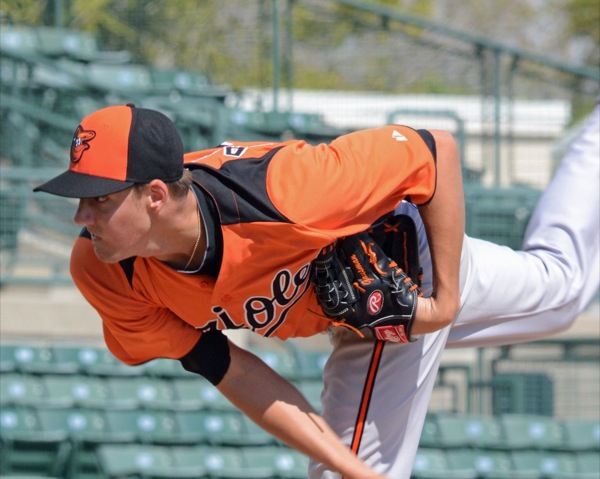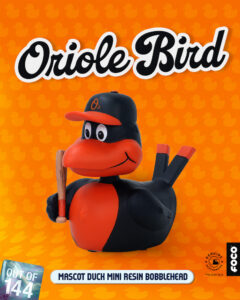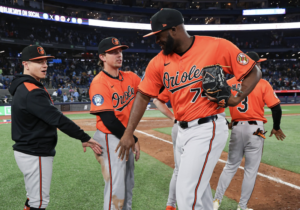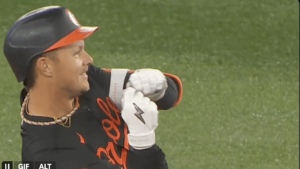“They need an ace.”
“They’re a collection of number three and four starters.”
“They will never win a World Series with that kind of rotation.”
We’ve all heard it – for the past three years, and even before that really. And we will continue to hear it until the Orioles do finally have an ace – which is hopefully this season or next, as hopefully at least one of Kevin Gausman or Dylan Bundy reach their potential.
Now, I can admit that the Orioles rotation is somewhat makeshift. Still, Chris Tillman took a huge leap forward over the past couple seasons and, hopefully, will continue to improve. Gausman is going to be a top-of-the-line guy soon, and Ubaldo Jimenez still has a chance to figure things out once again.
Wei-Yin Chen, Bud Norris, and Miguel Gonzalez are all solid contributors as well, which leads to a solid rotation.
So that begs the question – why the hate on the rotation? Why does no one seem to like the Orioles rotation?
To start, we need to understand the metrics used to measure pitching as well as defense, plus the correlation between pitching and defense; to be more exact, how much of pitching is quality pitching and how much is defense? There still really isn’t a definitive answer, but there have been breakthroughs as the SABR community continues to evolve.
ERA is still a great stat, but you can’t solely rely on it to tell you how good a pitcher is.
Another stats that is used to determine a pitcher’s true ability and performance is Fielding Independent Pitching. Essentially, FIP attempts to strip out the role of defense and luck, calculating, quite effectively, how a pitcher would have performed with league average defense behind him.
Basically, pitching is a extremely dependant on defense, aside from home runs, walks, and strikeouts. Pitchers have little control over what happens when a ball is put in play, so FIP attempts to paint a more accurate picture of a pitcher’s true performance.
While it can be a very effective tool to use when evaluating a pitcher, like all stats, it has its limitations. One of those glaring limitations is, apparently, the Baltimore Orioles.
Looking at strictly 2014, FIP and ERA differed drastically for the Orioles starters, despite FIP being designed to replicate ERA and be on the same scale as ERA. When a pitcher’s FIP is much higher than his ERA, it means one of two things: the pitcher got very lucky, or his defense was stellar.
So now lets look at some numbers.
Tillman pitched his way to a wonderful 3.34 ERA, but his FIP came in at 4.01.
Chen had a solid 3.54 ERA, while his FIP was 3.89.
Norris? Same story – a 3.65 ERA and a 4.22 FIP.
Gausman is the one exception; he posted a 3.57 ERA and a 3.41 FIP, showing that he actually pitched better than his ERA indicated.
I saved the best for last: Gonzalez had a beautiful 3.23 ERA, but according to FIP he was well below average – a 4.89 FIP is all he could muster!
So why do these number differ so much? I mentioned earlier that it is because the pitcher either got lucky, or his defense was fabulous. Obviously, anyone who watched the Orioles play in 2014 knows their defense was fantastic, but just to prove it, lets look at the metrics.
I’ll start with Defensive Runs Saved (DRS), widely considered the greatest single defensive statistic. In terms of the entire team, the Orioles ranked third, behind only the St. Louis Cardinals and Cincinnati Reds.
Another statistic to use would be Ultimate Zone Rating (UZR), in which the Orioles ranked second, behind only the baseball world’s favorite defensive team – the Kansas City Royals.
How about Defensive Efficiency, where the Orioles again rank second, behind only the Royals?
Orioles pitchers benefit greatly from the team’s spectacular defense, and while they aren’t the greatest rotation in the league, they pitch to their defense beautifully.
I believe in FIP and I do believe that it captures a pitcher’s true performance well, but when a team has a defense that ranks as well as the Orioles does, you have to consider the team’s defense as well. No, the Orioles rotation isn’t “elite,” but they pitch to the defense and the Orioles have created a rotation that is perfect for their team.
I should also note that 2014 wasn’t an outlier for the O’s in this regard.
In the magical 2012 season, the starters pitched to a 3.90 ERA, despite posting a 4.20 FIP. In 2013, their ERA rose to 4.20, and their FIP elevated only very slightly to 4.33. And finally, the team ERA and FIP in 2014 were 3.44 and 3.92.
Outpacing FIP – it’s what the Birds do! Thanks to their – again- elite defense.
The FIPs of the team didn’t vary but a little, but their ERA was respectable every year, despite bouncing up and down a bit. Essentially this proves the point that defense – especially in Baltimore – is a major factor in pitching results. Sure, that seems obvious, but remember it when you see what O’s starters are “projected” to do in 2015.
Look, this rotation wouldn’t be as good if they pitched in front of a league average or below average defense, but they benefit from a great defense and know how to pitch to it.
Some say the pitchers are bound to regress looking at ERA versus FIP, but I firmly believe that they will perform well yet again, and prove the doubters wrong yet again.










One Response
The royals and orioles are using the same formula as far as I can tell. Avoid awful starters and back them up with a quality defense. I think the royals and orioles would have similar offenses if they played all their games in the same park.